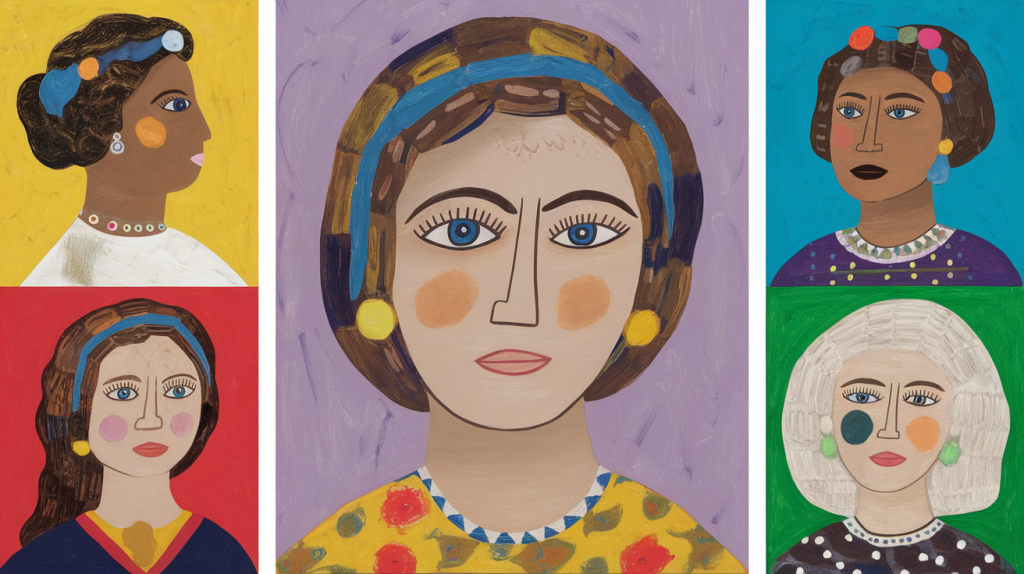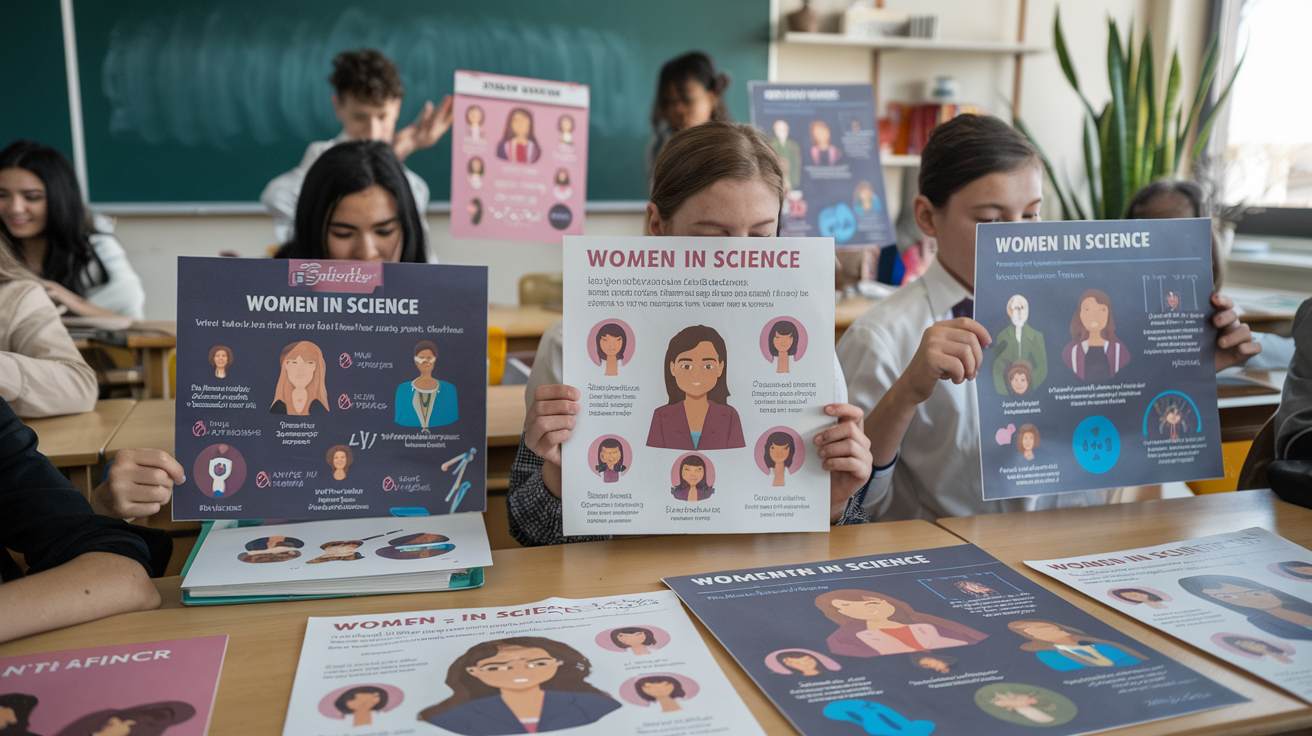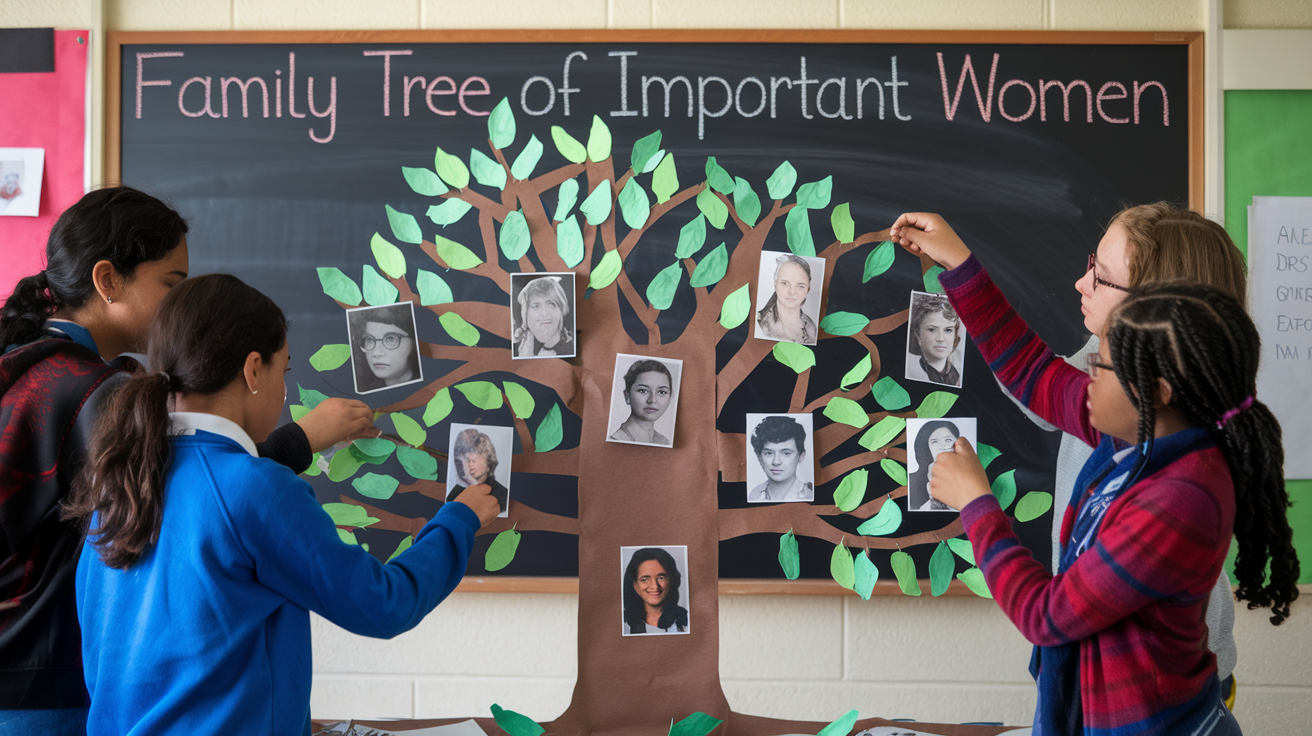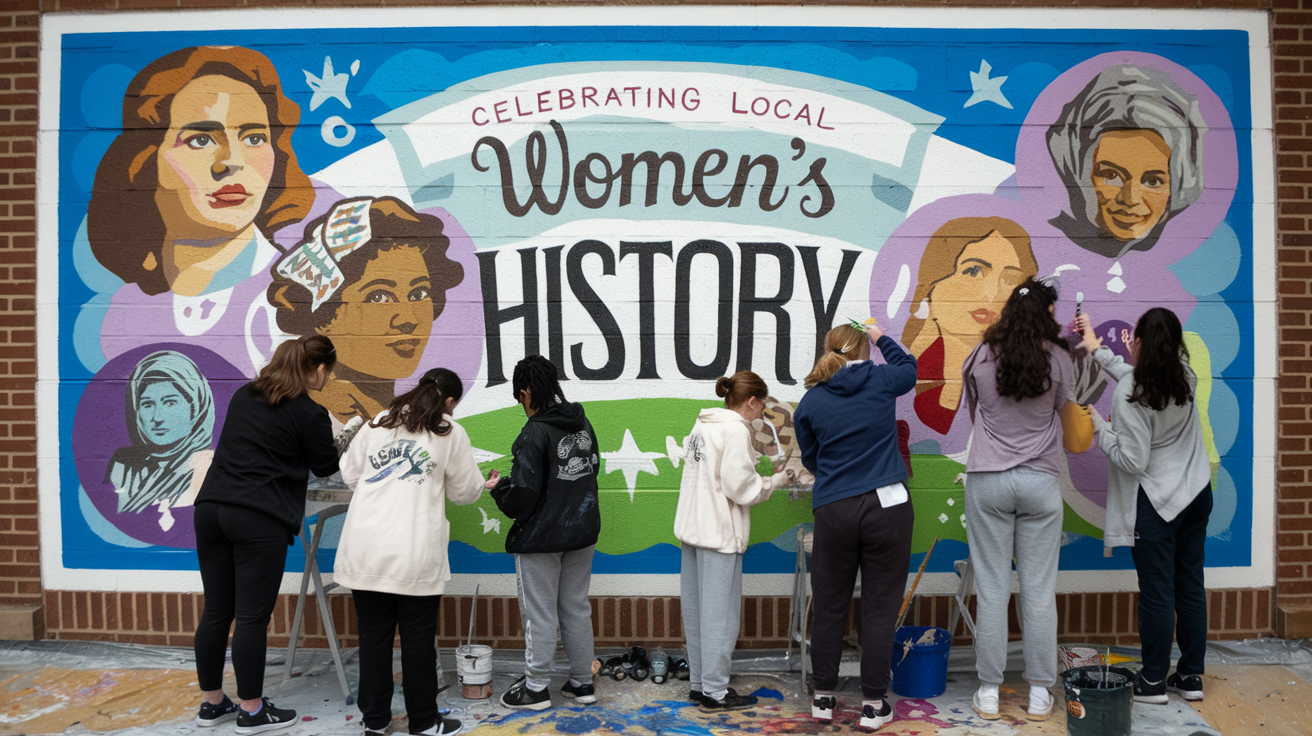Looking for meaningful ways to celebrate Women’s History Month in your classroom or community? You’re in the right place!
This collection features 21 inspiring art projects designed for all ages – from elementary students to high schoolers and community groups.
Each project connects creativity with powerful learning about women’s contributions throughout history.
The step-by-step instructions simplify and stress-free implementation, even if you’re not an art specialist.
These projects go beyond basic crafts. They encourage:
- Critical thinking
- Historical research
- Personal connections
- Collaborative learning
Whether you’re a classroom teacher scrambling for ideas or a parent wanting meaningful activities, these projects will engage your students while celebrating remarkable women past and present.
Let’s get creative!
Elementary School Art Projects
1. Historical Women Portrait Gallery

Create simple portraits of famous women throughout history using basic art supplies like colored pencils, markers, and construction paper. Students can choose women who inspire them, from scientists like Marie Curie to activists like Rosa Parks. Guide students to focus on distinctive features and include small symbolic items representing women’s achievements.
Unique Ideas:
- Students can create frames from cardboard with decorative elements that represent the woman’s era or achievements
- Add QR codes next to each portrait linking to age-appropriate biographies
- Display portraits timeline-style in school hallways to create an interactive walking exhibit
2. “I Am Strong Like…” Handprint Art

Students trace their hands on colorful paper, cut them out, and write the qualities of women they admire inside the handprint outline. Young students can focus on women in their families or communities, while older elementary students might include historical figures. Each finger of the handprint can contain a different quality.
Unique Ideas:
- Combine all handprints into a collaborative classroom display shaped like a heart or tree
- Add small photos or drawings of the admired women in the palm section
- Create a classroom book where each page features a student’s handprint and a short story about why they admire their chosen women
3. Women Inventors Collage
Students research women inventors and create visual representations of their inventions using a mix of drawing, painting, and collage techniques. Combine artistic elements with informative text blocks explaining the invention’s significance and impact on our daily lives.
Unique Ideas:
- Include before/after scenes showing life with and without the invention
- Create 3D elements that pop off the page for a more dynamic presentation
- Connect inventions with string to show how one innovation led to another
4. “When I Grow Up” Career Inspiration Boards

Students create mixed-media artwork depicting themselves in careers pioneered by women. They can incorporate photographs of their faces onto drawings of themselves in professional attire and settings. Encourage students to research what these professionals do day-to-day.
Unique Ideas:
- Include speech bubbles with affirmations like “I can be a pilot because Amelia Earhart showed me the way!”
- Create fold-out sections revealing facts about women who pioneered in these fields
- Display boards together as a “Future Leaders” wall during parent-teacher conferences
5. Paper Quilt of Notable Women

Each student creates a paper quilt square featuring a notable woman in history. Squares can include the woman’s portrait, symbols of her achievements, and a brief fact. Combine all squares into a classroom quilt celebrating women’s diverse contributions throughout history.
Unique Ideas:
- Use consistent border patterns that interlock when squares are placed together
- Include fabric scraps, buttons, or other tactile elements for sensory engagement
- Host a “quilt reveal” where students present their square and share what they learned
Middle School Art Projects
6. Women’s Rights Timeline Mural

Students collaborate to create a visual timeline showcasing key milestones in women’s rights history. Assign different periods to small groups who research and design their section. Use a long roll of paper along a hallway wall or create panel sections that can be displayed together.
Unique Ideas:
- Include pull-out interactive elements that reveal additional information
- Use a consistent color scheme with special highlight colors for breakthroughs
- Add silhouettes of ordinary women alongside famous figures to show the movement’s broad impact
7. Mixed Media “Shero” Portraits

Students create artistic tributes to their female heroes using paint, fabric scraps, magazine cutouts, and found objects. Encourage students to incorporate symbolic elements representing the woman’s achievements and character.
Unique Ideas:
- Create triptych panels showing different aspects of the hero’s life and work
- Incorporate quotes or poetry around the portrait’s border
- Use materials that connect symbolically to the subject (e.g., circuit board pieces for a computer scientist)
8. Women in Science Infographic Posters
Students combine artistic skills with data visualization to create informative and visually appealing posters about women scientists. They’ll research achievements, education pathways, and interesting facts while learning the principles of effective infographic design.
Unique Ideas:
- Include interactive elements like lift-the-flap sections revealing additional information
- Create visual metaphors that help explain complex scientific concepts
- Design complementary posters that can be displayed as a series, showing connections between different scientists’ work
9. “Breaking Barriers” Symbolic Sculpture
Students create three-dimensional art pieces representing obstacles women have overcome in various fields. Using materials like wire, cardboard, clay, and found objects, they’ll construct metaphorical sculptures that communicate concepts of strength and persistence.
Unique Ideas:
- Incorporate contrasting materials to represent conflict and resolution
- Design sculptures that cast meaningful shadows when lit from different angles
- Create accompanying artist statements explaining the symbolism in their work
10. Poetry and Art Journals Inspired by Women Poets
Students create illustrated journals featuring poems by famous women poets alongside their artistic interpretations and original poetry. They’ll explore techniques for visually representing poetic imagery and emotions through various creative mediums.
Unique Ideas:
- Use watercolor washes to create atmospheric backgrounds for poems
- Experiment with calligraphy and hand-lettering techniques for key phrases
- Create thematic visual motifs that appear throughout the journal to unify the collection
High School Art Projects
11. Women Artists Study and Emulation
Students research famous women artists from different periods and movements, analyzing their distinctive techniques and artistic approaches. They then create original artwork inspired by these artists’ styles while adding their contemporary perspective.
Unique Ideas:
- Create diptychs showing the original artist’s work alongside the student’s emulation
- Write analytical artist statements discussing technique, historical context, and personal interpretation
- Explore how these artists’ gender influenced their work and reception in the art world
12. Social Justice Poster Series
Students design powerful visual messages addressing women’s rights issues of their choosing. They’ll research current and historical challenges, learn principles of effective advocacy design, and create compelling imagery that communicates complex ideas succinctly.
Unique Ideas:
- Develop a cohesive series of 3-5 posters using consistent visual elements
- Incorporate data visualization techniques to present statistics impactfully
- Design for specific contexts (social media, school hallways, community spaces)
13. Digital “Hidden Figures” Photo Essay

Students document and celebrate lesser-known women who’ve made significant contributions to their communities or fields. Combining original photography, archival images, and well-researched text, they’ll create digital presentations highlighting overlooked achievements.
Unique Ideas:
- Include audio interviews or quotes from subjects or those who knew them
- Create before/after or then/now photo pairings to show historical context
- Design interactive timelines showing how these women’s work impacted subsequent developments
14. Identity and Intersectionality Self-Portraits

Students create complex self-portraits exploring female identity across cultures, backgrounds, and personal experiences. Using any medium or combination of techniques, they’ll express aspects of their identity that connect to broader themes of gender and intersectionality.
Unique Ideas:
- Incorporate cultural symbols and personal artifacts that represent heritage
- Use layering techniques to represent multiple facets of identity
- Create complementary written reflections exploring how gender intersects with other aspects of identity
15. Women’s Labor History Textile Art
Students learn about women’s contributions to labor movements while exploring traditional and contemporary textile techniques. They’ll create fiber art pieces that tell stories of women’s work, organizing, and the ongoing fight for workplace equality.
Unique Ideas:
- Incorporate actual work materials or symbols into the textile pieces
- Use traditional “women’s crafts” to subvert expectations about art forms
- Create collaborative pieces where individual sections tell personal or historical labor stories
Community and Family Art Projects
16. Family Tree of Important Women
Families create artistic genealogical displays highlighting important women in their lineage and community. They use photographs, drawings, and written stories to document female relatives’ experiences, talents, and contributions across generations.
Unique Ideas:
- Include artifacts or symbolic objects representing each woman’s life or work
- Create branches for “chosen family” and community mentors alongside biological relatives
- Include interactive elements like small booklets or recorded stories accessible via QR codes
17. Community Women Leaders Gallery
Students interview local women leaders and create their portraits using photography, painting, or mixed media. The project connects students with mentors while documenting important community contributions often overlooked in official histories.
Unique Ideas:
- Host an opening reception where subjects and artists can meet community members
- Create a digital archive of interviews accessible through QR codes next to each portrait
- Design the exhibition to travel to multiple community locations throughout the year
18. Intergenerational Story Quilts
Young people collaborate with older women in their families or communities to create textile art, telling shared stories. Participants learn traditional quilting techniques while exchanging narratives about women’s experiences across different eras.
Unique Ideas:
- Incorporate fabric from meaningful garments or household items
- Record stories about each quilt square to create an audio tour
- Display quilts in community spaces with explanatory materials about techniques and stories
19. Public Mural Celebrating Local Women’s History
Community members plan and execute a public mural highlighting women who shaped local history. The collaborative process involves research, design by professional artists, and painting opportunities for participants of all ages and skill levels.
Unique Ideas:
- Include interactive elements like embedded QR codes linking to additional information
- Design sections that different community groups can complete
- Create a time-lapse video documenting the creation process to share online
20. Women-Owned Business Art Walk
Students create art installations for display in women-owned local businesses. The project connects young artists with entrepreneurs while beautifying commercial spaces and highlighting the importance of women’s economic contributions.
Unique Ideas:
- Design art that reflects each business’s purpose and the owner’s journey
- Create maps for self-guided tours of all participating businesses
- Host a special evening event where business owners and artists discuss their work
21. Digital Archive of Women’s Oral Histories
Students record interviews with women from diverse backgrounds and create accompanying visual art representing their stories. The multimedia collection preserves important perspectives while teaching technical skills in audio recording, editing, and digital art.
Unique Ideas:
- Create visual “sound waves” artwork that incorporates quotes from the interviews
- Develop an interactive timeline showing connections between different women’s experiences
- Build a searchable online archive organized by themes, periods, and geographic locations
I hope these project ideas inspire some wonderful creative exploration! Remember that the best art projects allow personal expression while teaching new skills and perspectives.
Have fun creating!
Conclusion
Art lets us celebrate women’s stories in powerful ways. These 21 projects offer something for every age and skill level.
The most important thing is to start creating. Pick one project that excites you and dive in. You don’t need fancy supplies or perfect skills.
What matters is the conversations these projects spark. When students connect art with history, the learning goes deeper. They see themselves in the stories of remarkable women.
Remember to share your creations with others—display projects in hallways, community spaces, or online galleries.
Women’s History Month is just the beginning. These art activities build awareness that extends throughout the year.
So gather your supplies, inspire your students, and watch art transform how they see women’s contributions to our world.
Happy creating!
Frequently Asked Questions
How Do I Adapt These Projects for Different Age Groups?
For younger students, simplify the research and focus on basic art skills. Older students can dive deeper into the historical context and use more advanced techniques. Many projects include age-specific modifications in the instructions.
Do I Need to Be an Art Teacher to Use These Projects?
Not at all! Each project comes with clear, step-by-step directions anyone can follow. The supply lists focus on basic materials most classrooms already have. You don’t need special art training to lead these activities.
How Can I Connect These Art Projects to Our Curriculum Standards?
These projects align with social studies, language, and visual arts standards. Each project description includes suggested curriculum connections. They support learning objectives related to historical understanding, research skills, and creative expression.
What if We Have Limited Art Supplies?
Many projects offer “budget-friendly” alternatives using everyday materials. The “Materials Needed” section highlights essential items versus optional extras. Several projects can also be adapted to use recycled materials from home.
How Long Do These Projects Typically Take to Complete?
Most projects can be completed in 1-3 class periods. The timeline section breaks down each project into manageable steps. Some projects, especially collaborative ones, can be extended over several days or weeks if desired.






















